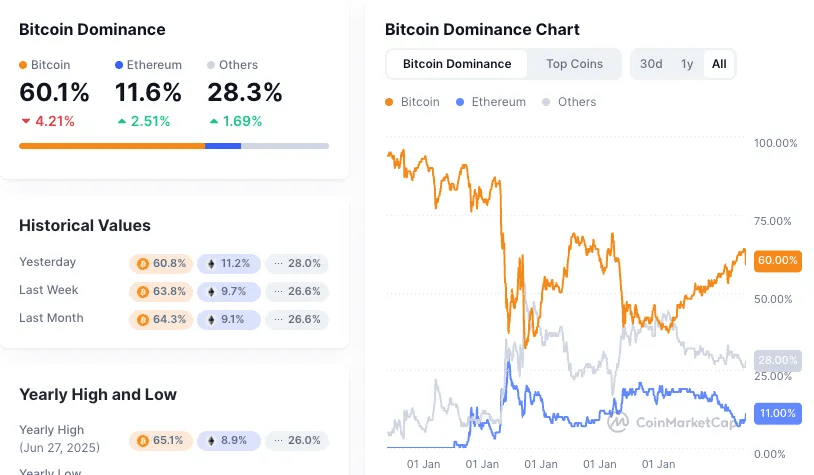As of Monday (July 21) in Asia, Bitcoin was trading at approximately $118,300, slightly below last week's all-time high of $123,000. Ethereum outperformed the world's largest crypto asset again, trading at $3,750.15, up 4% in the past 24 hours and 26% over the past week, with funds continuing to flow into high-beta assets.
Bitcoin remains stable around $118,300, consolidating in a narrow range. Following strong institutional funding in early trading, selling occurred towards the end, breaking below the key support of $118,000, indicating a possible deeper correction.
Ethereum rose by 3.78%, with institutional funds continuing to flow in, while funds were withdrawn from smaller altcoins. Analysts warn that the rise in momentum and the $331 million bearish bets could trigger short covering, further pushing up the market.
The CoinDesk 20 Index reported 4,071.75, showing that investor appetite remains strong. However, new data from CryptoQuant indicates that there may be turmoil brewing beneath the surface of the market.
On Monday morning, Bitcoin's market share briefly fell below 60%, the first time since March of this year. This metric measures Bitcoin's proportion of the total market capitalization of the cryptocurrency market, which dropped to 59.8% during early trading.

This decline reflects a stronger performance of altcoins among major digital assets. Ethereum rose by 4%, while Ripple (XRP) and Solana increased by 2% and 3%, respectively. During the same period, Bitcoin itself fell by 1%.
Market dynamics show that portfolios are accelerating the rebalancing towards alternative cryptocurrencies. Thematic tokens have also surged significantly with the overall strength of altcoins. As of the time of writing, Bitcoin's market share has rebounded to 60.1%.
On-chain dynamics
On July 15, the number of Bitcoins flowing into exchanges surged to 81,000 BTC, the highest single-day inflow since February of this year. This inflow was driven by 'whales' and miners: the total volume of transfers exceeding 100 BTC soared from 13,000 BTC to 58,000 BTC, while miners' outflows reached 16,000 BTC, almost all of which were deposited directly into exchanges.
Ethereum showed a similar pattern. On July 16, approximately 2 million ETH flowed into exchanges, marking the highest single-day inflow since the end of February, with total inflows increasing by 131% since April.
CryptoQuant also pointed out that miner wallet balances have decreased from 68,000 BTC to 65,000 BTC since June 26, further corroborating the view that miners realized profits during last week's market conditions.
Large holders and miners selling at high levels suggest that the market may be at a local top or entering a phase of increased volatility. Historically, inflows of this scale often indicate a price correction, so this could be a cautious signal for traders. While overall bullish momentum still exists, these signals cannot be ignored.
Singaporean market maker Enflux is closely monitoring technical indicators. In a recent report to CoinDesk, the company stated: 'Liquidity remains healthy, and we are watching for confirmation signals in perpetual contract open interest and altcoin depth. If Ethereum's dominance continues to rise, we expect trailing momentum in mid-cap coins to last until next week.'
Meanwhile, altcoin inflows remain sluggish. The daily trading volume of altcoins flowing into exchanges is only 31,000 transactions, far below the 120,000 transactions seen during market peaks in March and December 2024.
CryptoQuant believes this indicates low selling pressure, suggesting that altcoin holders may have stronger conviction, slower capital rotation, or are simply waiting for new catalysts. Currently, Bitcoin and Ethereum remain the market focus, but over-the-counter funds could become active again at any time.
The Japanese elections are driving the process of cryptocurrency tax reform.
The ruling Liberal Democratic Party of Japan faced its worst election defeat in decades. It lost its parliamentary majority in both houses for the first time since 1955. The coalition partner Komeito lost at least two seats in the Sunday Senate elections, failing to maintain control.
This historic change is exacerbating unprecedented political instability against a backdrop of rising living costs and stagnant wages. As the populist opposition gains more leverage, Prime Minister Shigeru Ishiba faces calls to resign from within his party. The market anticipates volatility as the government negotiates from a weakened position.
The election results significantly accelerated discussions on cryptocurrency tax reform. The opposition party widely campaigned on tax cuts, especially targeting crypto assets. The Japan Blockchain Association has submitted a proposal to change the current maximum comprehensive tax rate of 55% to a single separation tax rate of 20.315%.
Despite high taxes, Japan remains the fifth-largest cryptocurrency trading market in the world. The Bitcoin to Japanese Yen trading pair is the third-largest market globally, and regulatory restrictions have not hindered demand. Corporate Bitcoin adoption is also accelerating in Japan, with MetaPlanet becoming the world's fifth-largest institutional holder.
